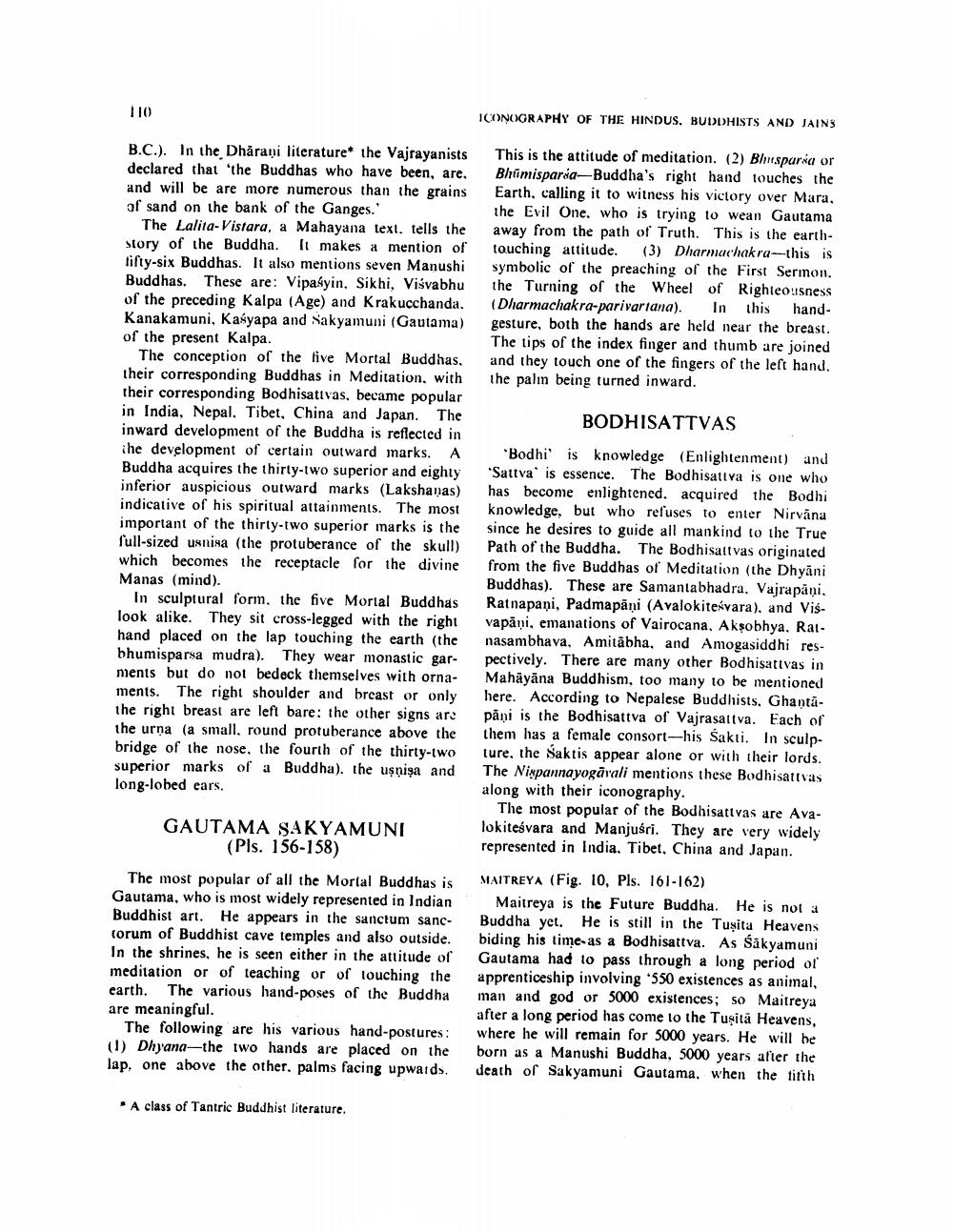________________
110
B.C.). In the Dharani literature* the Vajrayanists declared that 'the Buddhas who have been, are. and will be are more numerous than the grains of sand on the bank of the Ganges."
The Lalita-Vistara, a Mahayana text. tells the story of the Buddha. It makes a mention of fifty-six Buddhas. It also mentions seven Manushi Buddhas. These are: Vipasyin, Sikhi, Viśvabhu of the preceding Kalpa (Age) and Krakucchanda. Kanakamuni, Kasyapa and Sakyamuni (Gautama) of the present Kalpa.
The conception of the five Mortal Buddhas. their corresponding Buddhas in Meditation, with their corresponding Bodhisattvas, became popular in India, Nepal. Tibet, China and Japan. The inward development of the Buddha is reflected in the development of certain outward marks. A Buddha acquires the thirty-two superior and eighty inferior auspicious outward marks (Lakshanas) indicative of his spiritual attainments. The most important of the thirty-two superior marks is the full-sized usnisa (the protuberance of the skull) which becomes the receptacle for the divine Manas (mind).
In sculptural form. the five Mortal Buddhas look alike. They sit cross-legged with the right hand placed on the lap touching the earth (the bhumisparsa mudra). They wear monastic garments but do not bedeck themselves with ornaments. The right shoulder and breast or only the right breast are left bare: the other signs are the urna (a small, round protuberance above the bridge of the nose, the fourth of the thirty-two superior marks of a Buddha). the uşnişa and long-lobed ears.
GAUTAMA SAKYAMUNI (Pls. 156-158)
The most popular of all the Mortal Buddhas is Gautama, who is most widely represented in Indian Buddhist art. He appears in the sanctum sanctorum of Buddhist cave temples and also outside. In the shrines, he is seen either in the attitude of meditation or of teaching or of touching the earth. The various hand-poses of the Buddha are meaningful.
The following are his various hand-postures: (1) Dhyana-the two hands are placed on the lap, one above the other, palms facing upwards.
A class of Tantric Buddhist literature.
ICONOGRAPHY OF THE HINDUS, BUDDHISTS AND JAINS
This is the attitude of meditation. (2) Bhusparsa or Bhumisparia-Buddha's right hand touches the Earth, calling it to witness his victory over Mara. the Evil One, who is trying to wean Gautama away from the path of Truth. This is the earthtouching attitude. (3) Dharmachakra-this is symbolic of the preaching of the First Sermon. the Turning of the Wheel of Righteousness (Dharmachakra-parivartana). In this handgesture, both the hands are held near the breast. The tips of the index finger and thumb are joined and they touch one of the fingers of the left hand. the palm being turned inward.
BODHISATTVAS
'Bodhi' is knowledge (Enlightenment) and 'Sattva is essence. The Bodhisattva is one who has become enlightened. acquired the Bodhi knowledge, but who refuses to enter Nirvana since he desires to guide all mankind to the True Path of the Buddha. The Bodhisattvas originated from the five Buddhas of Meditation (the Dhyani Buddhas). These are Samantabhadra. Vajrapani. Ratnapani, Padmapāņi (Avalokitesvara), and Visvapāņi, emanations of Vairocana. Akṣobhya, Ratnasambhava. Amitabha, and Amogasiddhi respectively. There are many other Bodhisattvas in Mahayana Buddhism, too many to be mentioned here. According to Nepalese Buddhists. Ghantapani is the Bodhisattva of Vajrasattva. Each of them has a female consort-his Sakti. In sculpture, the Saktis appear alone or with their lords. The Nispannayogavali mentions these Bodhisattvas along with their iconography.
The most popular of the Bodhisattvas are Avalokitesvara and Manjuśri. They are very widely represented in India. Tibet, China and Japan.
MAITREYA (Fig. 10, Pls. 161-162)
Maitreya is the Future Buddha. He is not a Buddha yet. He is still in the Tusita Heavens biding his time as a Bodhisattva. As Sakyamuni Gautama had to pass through a long period of apprenticeship involving '550 existences as animal, man and god or 5000 existences; so Maitreya after a long period has come to the Tuşită Heavens, where he will remain for 5000 years. He will be born as a Manushi Buddha, 5000 years after the death of Sakyamuni Gautama. when the fifth




